Halogen-Free Waterborne Polymeric Hybrid Coatings for Improved Fire Retardancy of Textiles
Abstract
:1. Introduction
2. Materials and Methods
2.1. Materials
2.2. Synthesis of Copolymer Emulsion
2.3. Preparation of FR Compositions for the Textile Coating
2.4. Application of FR Compositions to Fabrics
2.5. Characterization Methods
3. Results and Discussion
3.1. Copolymer Properties
3.2. Properties of FR Compositions
3.2.1. Thermo-Mechanical Properties
3.2.2. Flow Behavior of the FR Composites
3.2.3. Fire-Retardant Properties
4. Conclusions
Author Contributions
Funding
Institutional Review Board Statement
Data Availability Statement
Acknowledgments
Conflicts of Interest
References
- Liu, J.; Qi, P.; Meng, D.; Li, L.; Sun, J.; Li, H.; Gu, X.; Jiang, S.; Zhang, S. Eco-friendly flame retardant and smoke suppression coating containing boron compounds and phytic acids for nylon/cotton blend fabrics. Ind. Crop. Prod. 2022, 186, 115239. [Google Scholar] [CrossRef]
- Horrocks, A.R.; Kandola, B.K.; Davies, P.J.; Zhang, S.; Padbury, S.A. Developments in flame retardant textiles—A review. Polym. Degrad. Stab. 2005, 88, 3–12. [Google Scholar] [CrossRef]
- Horrocks, A.R. Flame retardant challenges for textiles and fibres: New chemistry versus innovatory solutions. Polym. Degrad. Stab. 2011, 96, 377–392. [Google Scholar] [CrossRef]
- Malucelli, G.; Carosio, F.; Alongi, J.; Fina, A.; Frache, A.; Camino, G. Materials engineering for surface-confined flame retardancy. Mater. Sci. Eng. R. 2014, 84, 1–20. [Google Scholar] [CrossRef]
- Birnbaum, L.S.; Staskal, D.F. Brominated flame retardants: Cause for concern? Environ. Health Perspect. 2004, 112, 9–17. [Google Scholar] [CrossRef] [PubMed]
- Torre, A.; Navarro, I.; Sanz, P.; Martínez, M.Á. Organophosphate compounds, polybrominated diphenyl ethers and novel brominated flame retardants in European indoor house dust: Use, evidence for replacements and assessment of human exposure. J. Hazard. Mater. 2020, 382, 121009. [Google Scholar] [CrossRef]
- Yu, Z.; Liu, J.; He, H.; Ma, S.; Yao, J. Flame-retardant PNIPAAm/sodium alginate/polyvinyl alcohol hydrogels used for fire-fighting application: Preparation and characteristic evaluations. Carbohydr. Polym. 2021, 255, 117485. [Google Scholar] [CrossRef]
- Kanat, M.; Eren, T. Synthesis of phosphorus-containing flame retardants and investigation of their flame retardant behavior in textile applications. J. Appl. Polym. Sci. 2019, 136, 47935. [Google Scholar] [CrossRef]
- Cheng, X.W.; Wu, Y.X.; Huang, Y.T.; Jiang, J.R.; Xu, J.T.; Guan, J.P. Synthesis of a reactive boron-based flame retardant to enhance the flame retardancy of silk. React. Funct. Polym. 2020, 156, 104731. [Google Scholar] [CrossRef]
- Malucelli, G.; Bosco, F.; Alongi, J.; Carosio, F.; Di Blasio, A.; Mollea, C.; Cuttica, F.; Casale, A. Biomacromolecules as novel green flame retardant systems for textiles: An overview. RSC Adv. 2014, 4, 46024–46039. [Google Scholar] [CrossRef]
- Costes, L.; Laoutid, F.; Brohez, S.; Dubois, P. Bio-based flame retardants: When nature meets fire protection. Mater. Sci. Eng. R. 2017, 117, 1–25. [Google Scholar] [CrossRef]
- Basak, S.; Ali, S.W. Sustainable fire retardancy of textiles using bio-macromolecules. Polym. Degrad. Stab. 2016, 133, 47–64. [Google Scholar] [CrossRef]
- Alongi, J.; Bosco, F.; Carosio, F.; Di Blasio, A.; Malucelli, G. A new era for flame retardant materials? Mater. Today 2014, 17, 152–153. [Google Scholar] [CrossRef]
- Yang, T.T.; Guan, J.P.; Tang, R.C.; Chen, G. Condensed tannin from Dioscorea cirrhosa tuber as an eco-friendly and durable flame retardant for silk textile. Ind. Crop. Prod. 2018, 115, 16–25. [Google Scholar] [CrossRef]
- El Messoudi, M.; Boukhriss, A.; Bentis, A.; El Bouchti, M.; Ait Chaoui, M.; El Kouali, M.H.; Gmouh, S. Flame retardant finishing of cotton fabric based on ionic liquid compounds containing boron prepared with the sol-gel method. J. Coat. Technol. Res. 2022, 19, 1609–1619. [Google Scholar] [CrossRef]
- Ozcelik, G.; Elcin, O.; Guney, S.; Erdem, A.; Hacioglu, F.; Dogan, M. Flame-retardant features of various boron compounds in thermoplastic polyurethane and performance comparison with aluminum trihydroxide and magnesium hydroxide. Fire Mater. 2022, 46, 1020–1033. [Google Scholar] [CrossRef]
- Liu, H.; Du, Y.; Lei, S.; Liu, Z. Flame-retardant activity of modified boron nitride nanosheets to cotton. Text. Res. J. 2020, 90, 512–522. [Google Scholar] [CrossRef]
- Shao, Z.B.; Wang, T.C.; Lin, X.B.; Song, X.; Cui, J.; Zhang, S.; Zhu, L. Facile construction of ınorganic phosphorus/boron-layered double hydroxide complexes for highly efficient fire-safety epoxy resin. ACS Appl. Polym. Mater. 2023, 5, 3768–3776. [Google Scholar] [CrossRef]
- Kundu, C.K.; Song, L.; Hu, Y. Multi elements-based hybrid flame retardants for the superior fire performance of polyamide 66 textiles. J. Taiwan Inst. Chem. Eng. 2021, 118, 284–293. [Google Scholar] [CrossRef]
- Liu, Y.; Pan, Y.T.; Wang, X.; Acuna, P.; Zhu, P.; Wagenknecht, U.; Heinrich, G.; Zhang, X.Q.; Wang, R.; Wang, D.Y. Effect of phosphorus-containing inorganic-organic hybrid coating on the flammability of cotton fabrics: Synthesis, characterization and flammability. Chem. Eng. J. 2016, 294, 67–175. [Google Scholar] [CrossRef]
- Qian, Y.; Wei, P.; Jiang, P.K.; Zhao, X.M.; Yu, H.Z. Synthesis of a novel hybrid synergistic flame retardant and its application in PP/IFR. Polym. Degrad. Stab. 2011, 96, 1134–1340. [Google Scholar] [CrossRef]
- Qian, X.; Song, L.; Yuan, B.; Yu, B.; Shi, Y.; Hu, Y.; Yuen, R.K.K. Organic/inorganic flame retardants containing phosphorus, nitrogen and silicon: Preparation and their performance on the flame retardancy of epoxy resins as a novel intumescent flame retardant system. Mater. Chem. Phys. 2014, 143, 1243–1252. [Google Scholar] [CrossRef]
- Qi, L.; Qiu, S.; Xi, J.; Yu, B.; Hu, Y.; Xing, W. Construction of super-hydrophobic, highly effective flame retardant coating for cotton fabric with superior washability and abrasion resistance. J. Colloid Interface Sci. 2022, 607, 2019–2028. [Google Scholar] [CrossRef]
- Li, M.; Prabhakar, M.N.; Song, J. Synthesis of novel Si–P–N complex coating for the fabrication of flame-retardant and hydrophobic cotton textile potentially suitable for rail seat cover. Prog. Org. Coat. 2022, 172, 107144. [Google Scholar] [CrossRef]
- Yang, Y.; Wang, X.; Cheng, X.; Li, H.; Gu, X.; Sun, J.; Zhang, S. Improving the flame retardant and antibacterial performance of polyester/cotton blend fabrics with organic-inorganic hybrid coating. Polym. Degrad. Stab. 2022, 200, 109944. [Google Scholar] [CrossRef]
- Nie, Y.; Mugaanire, I.T.; Guo, Y.; Wang, R.; Hou, K.; Zhu, M. A hybrid hydrogel/textile composite as flame-resistant dress. Prog. Nat. Sci. Mater. Int. 2021, 31, 33–40. [Google Scholar] [CrossRef]
- Li, G.; You, F.; Zhou, S.; Wang, Z.; Li, D.; Zhang, X.; Zhou, C.; Zhuang, C.; Zhao, Y. Preparations, characterizations, thermal and flame retardant properties of cotton fabrics finished by boron-silica sol-gel coatings. Polym. Degrad. Stab. 2022, 202, 110011. [Google Scholar] [CrossRef]
- Fan, F.; Xia, Z.; Li, Q.; Li, Z.; Chen, H. Thermal stability of phosphorus-containing styrene–acrylic copolymer and its fire retardant performance in waterborne intumescent coatings. J. Therm. Anal. Calorim. 2013, 114, 937–946. [Google Scholar] [CrossRef]
- Malucelli, G.; Barbalini, M. UV-curable acrylic coatings containing biomacromolecules: A new fire retardant strategy for ethylene-vinyl acetate copolymers. Prog. Org. Coat. 2019, 127, 330–337. [Google Scholar] [CrossRef]
- Wesolek, D.; Gasiorowski, R.; Rojewski, S.; Walentowska, J.; Wojcik, R. New flexible flame retardant coatings based on siloxane resin and ethylene-vinyl chloride copolymer. Polymers 2016, 8, 419. [Google Scholar] [CrossRef]
- Huang, T.; Gong, S. Preparation of Emulsifier-Free Styrene–Acrylic Emulsion via Reverse Iodine Transfer Polymerization. Polymers 2021, 13, 3348. [Google Scholar] [CrossRef] [PubMed]
- Wu, J.; Bi, J.; Xu, B.; Fu, L.; Hao, W. Enhanced Flame Retardancy of Styrene-Acrylic Emulsion Based Damping Composites Based on an APP/EG Flame-Retardant System. Materials 2023, 16, 3894. [Google Scholar] [CrossRef] [PubMed]
- Liu, Z.; Dai, M.; Zhang, Y.; Gao, X.; Zhang, Q. Preparation and performances of novel waterborne intumescent fire retardant coatings. Prog. Org. Coat. 2016, 95, 100–106. [Google Scholar] [CrossRef]
- Chuang, C.S.; Tsai, K.C.; Wang, M.K.; Ko, C.H.; Ing-Luen, S. Impact of the intumescent formulation of styrene acrylic-based coatings on the fire performance of thin painted red lauan (Parashorea spp.) plywood. Eur. J. Wood Prod. 2009, 67, 407–415. [Google Scholar] [CrossRef]
- Jun, Y.; Jin, Y.; Sun, L.; Xu, G.; Li, Z. Preparation, structure and application of styrene-acrylic emulsion/modified ammonium polyphosphate in flame retardant air filter paper. J. Ind. Text. 2022, 51, 7223S–7238S. [Google Scholar] [CrossRef]
- Zakikhani, M. Flame Retardant Polymer Emulsion. EU Patent EP1,739,109,A1, 28 June 2007. [Google Scholar]
- Van Leuven, I.; Duyvejonck, W. Flame Retardant Composition for Textile. EU Patent EP2,813,616,A1, 17 December 2014. [Google Scholar]
- Lihong, Y. Formula of Expandable Acrylic Fireproof Paint. WO Patent WO2016078154A1, 24 September 2014. [Google Scholar]
- ISO 15025:2016; Protective Clothing. Protection against Flame. Method of Test for Limited Flame Spread. International Organization for Standardization: Geneva, Switzerland, 2016. Available online: https://www.iso.org/standard/61739.html (accessed on 1 November 2023).
- ASTM D2863-23; Standard Test Method for Measuring the Minimum Oxygen Concentration to Support Candle-Like Combustion of Plastics (Oxygen Index). ASTM International: West Conshohocken, PA, USA, 2023. Available online: https://www.astm.org/d2863-23.html (accessed on 1 November 2023).
- Smith, A.L. The Coblentz Society Desk Book of Infrared Spectra, 2nd ed.; Carver, C.D., Ed.; The Coblentz Society: Kirkwood, MO, USA, 1982; pp. 1–24. [Google Scholar]
- Li, Q.; Xu, K.; Wang, X.; Huang, H.; Ma, L.; Bi, C.; Yang, Z.; Li, Y.; Zhao, Y.; Fan, S.; et al. The role of structural order and stiffness in the simultaneous enhancement of optical contrast and thermal stability in phase change materials. J. Mater. Chem. C 2019, 7, 4132–4142. [Google Scholar] [CrossRef]
- Hull, T.R.; Witkowski, A.; Hollingbery, L. Fire retardant action of mineral fillers. Polym. Degrad. Stab. 2011, 96, 1462–1469. [Google Scholar] [CrossRef]
- Hornsby, P.R. Fire retardant fillers for polymers. Int. Mater. Rev. 2001, 46, 199–210. [Google Scholar] [CrossRef]
- Mezger, T.G. The Rheology Handbook, 2nd ed.; Vincentz Network GmbH & Co.KG: Hannover, Germany, 2006. [Google Scholar]
- Yilmaz, O.; Cheaburu, C.N.; Gulumser, G.; Vasile, C. Rheological behaviour of acrylate/montmorillonite nanocomposite latexes and their application in leather finishing as binders. Prog. Org. Coat. 2011, 70, 52–58. [Google Scholar] [CrossRef]
- Brummer, R. Rheology Essentials of Cosmetic and Food Emulsions, 1st ed.; Springer: Berlin/Heidelberg, Germany, 2006. [Google Scholar]
- Horrocks, A.R.; Tunc, M.; Price, D. The burning behaviour of textiles and its assessment by oxygen-index methods. Text. Prog. 1988, 18, 1–186. [Google Scholar] [CrossRef]

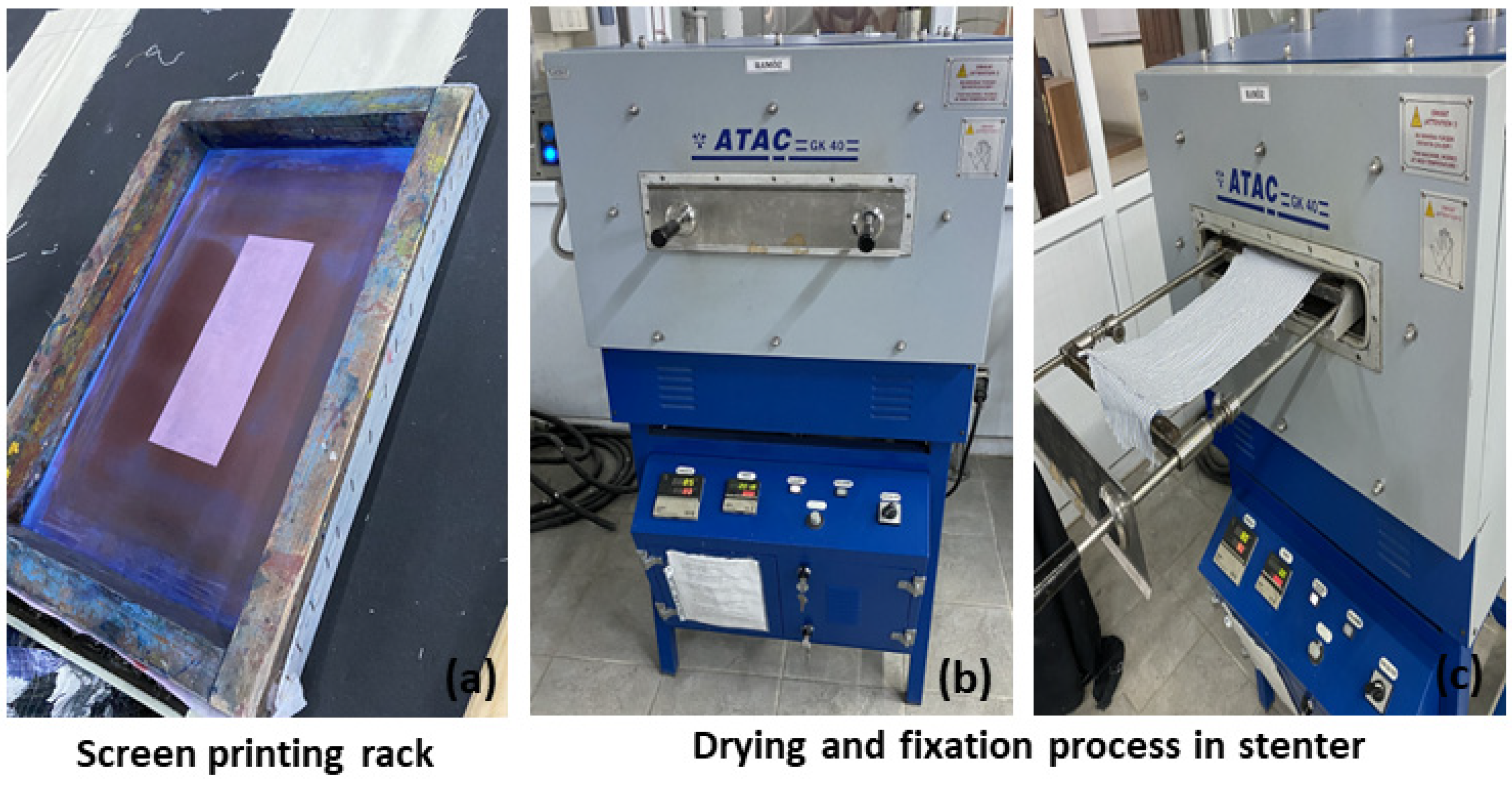
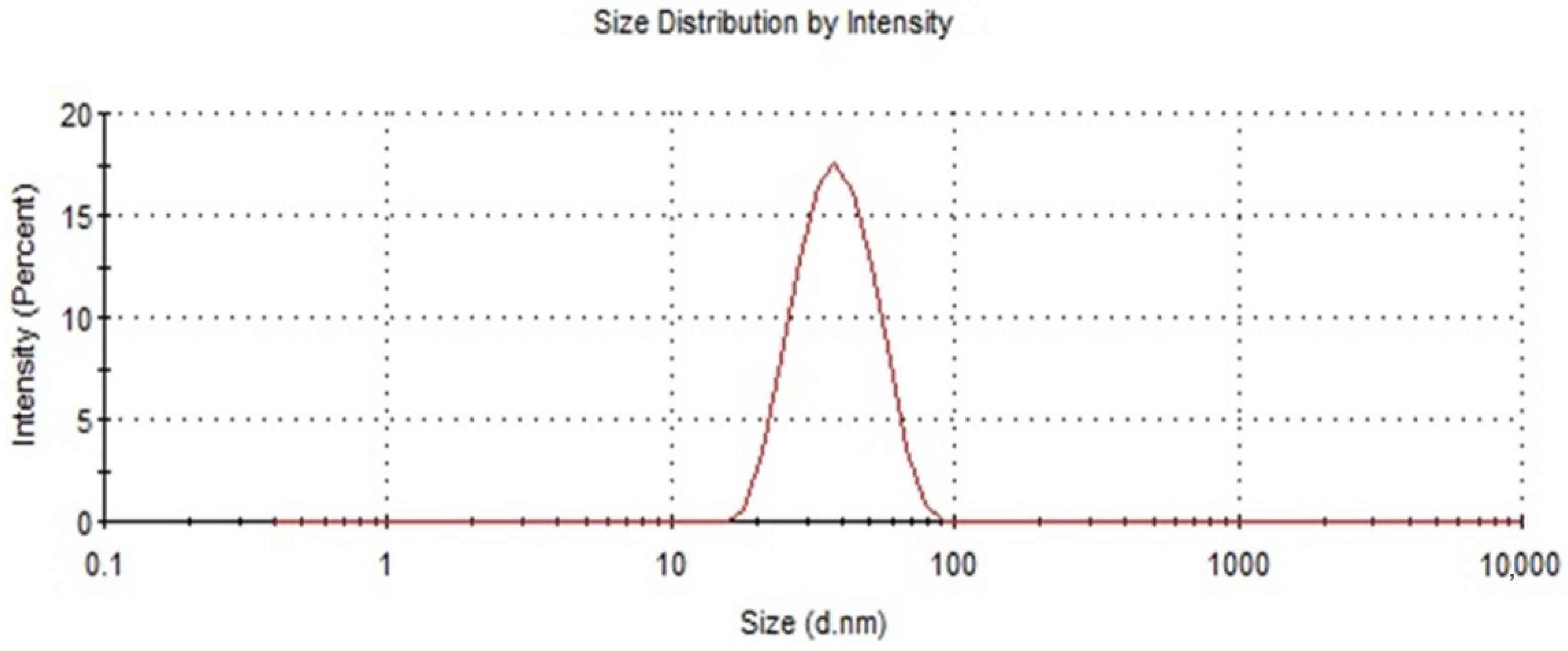

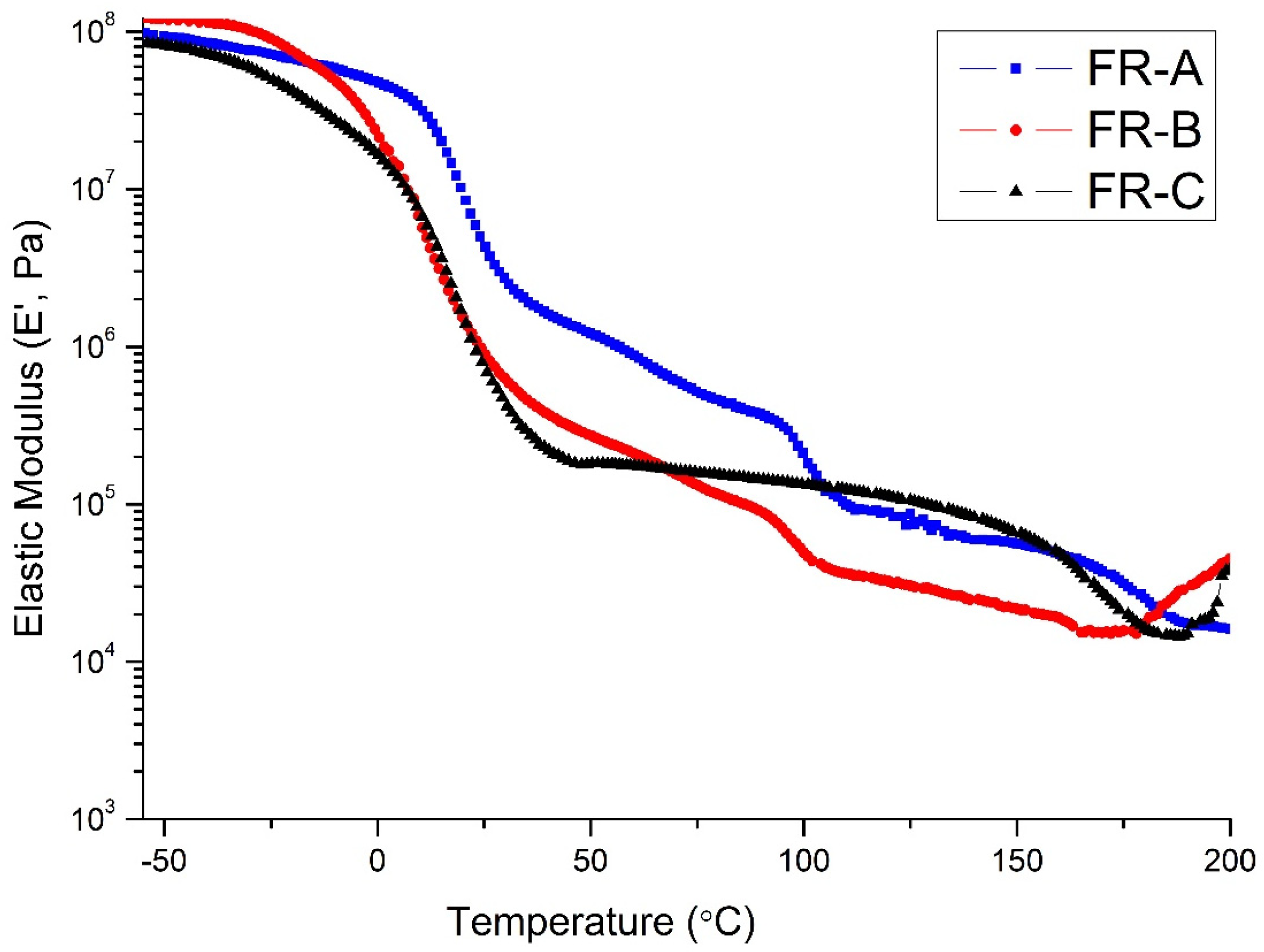
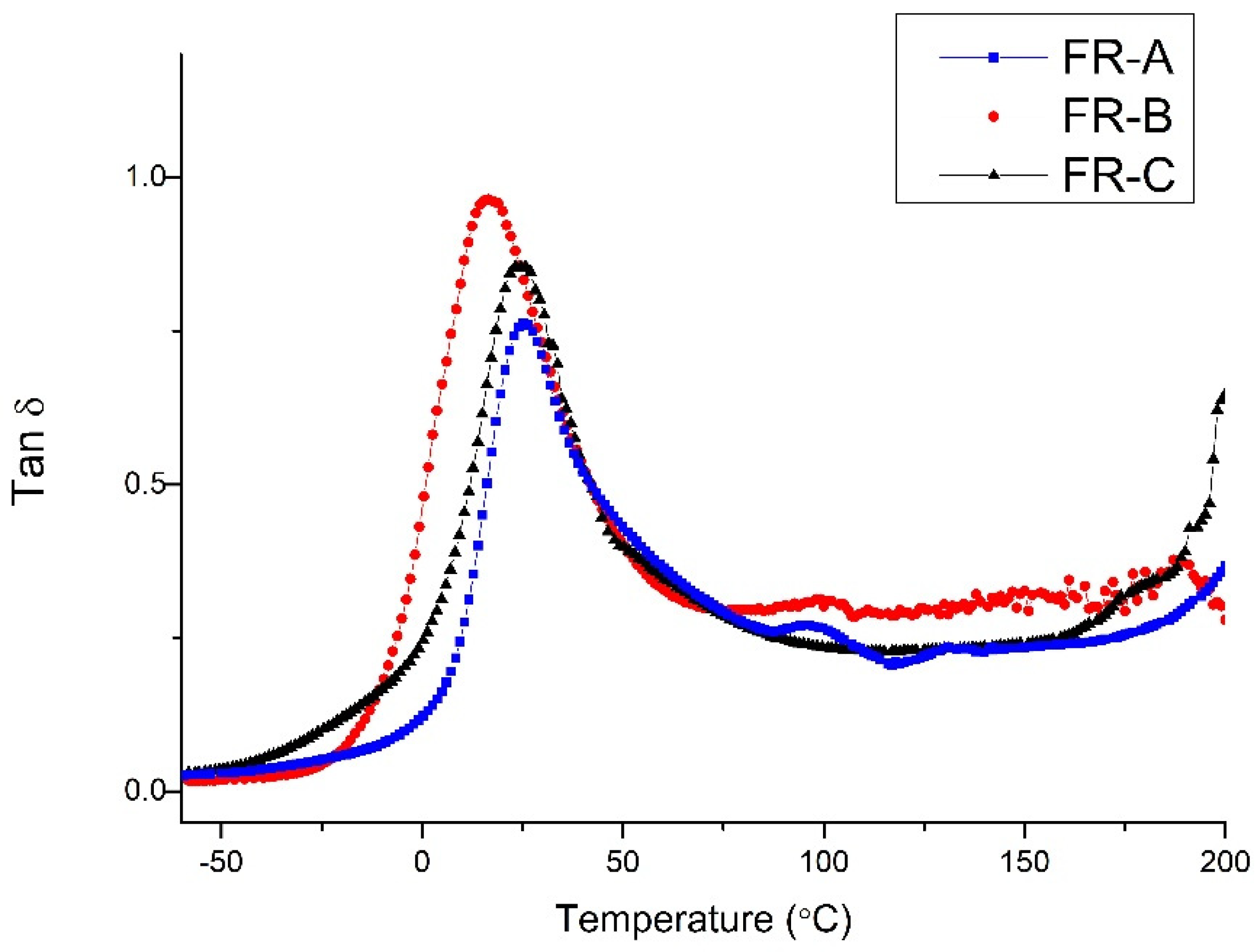

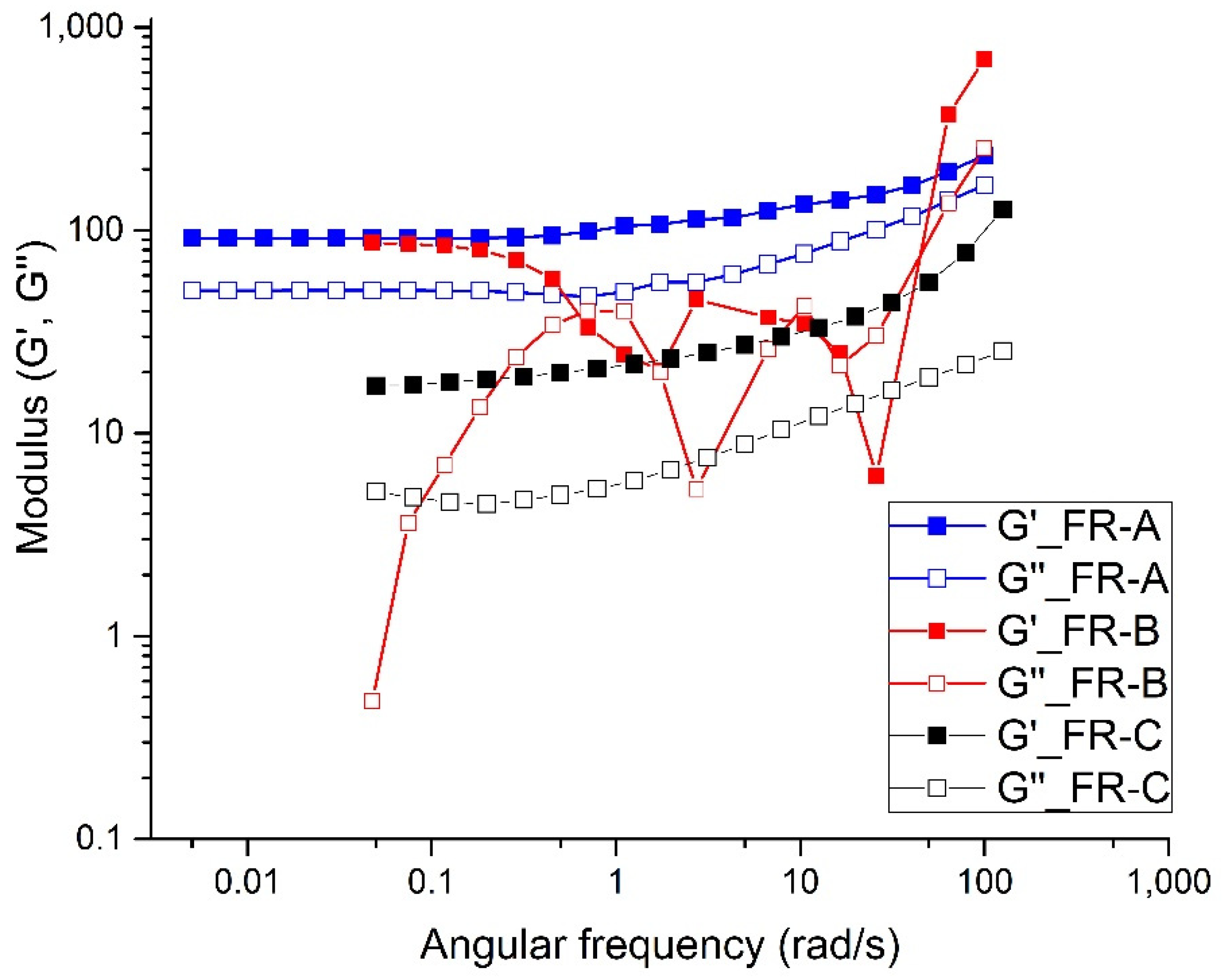
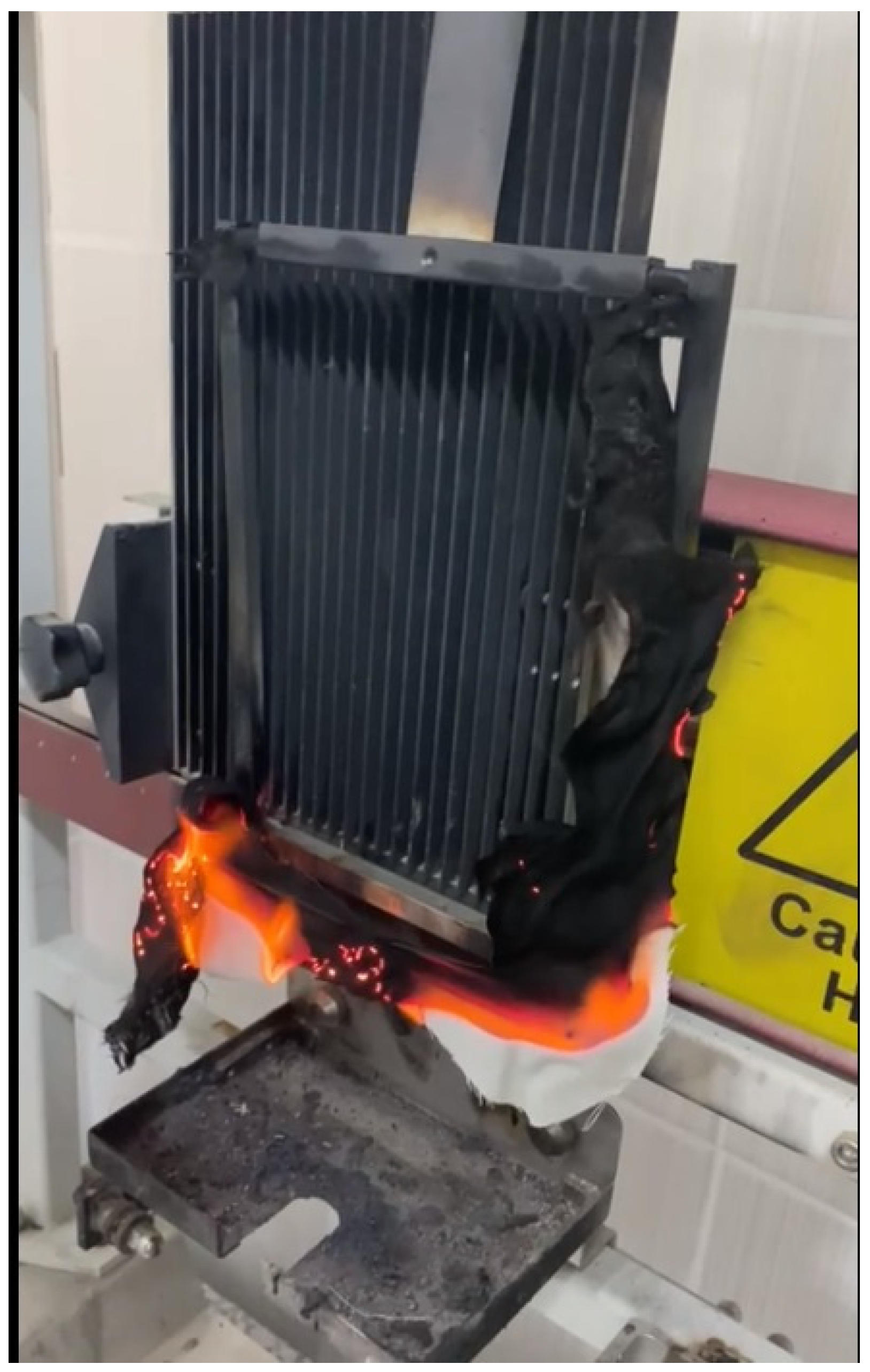
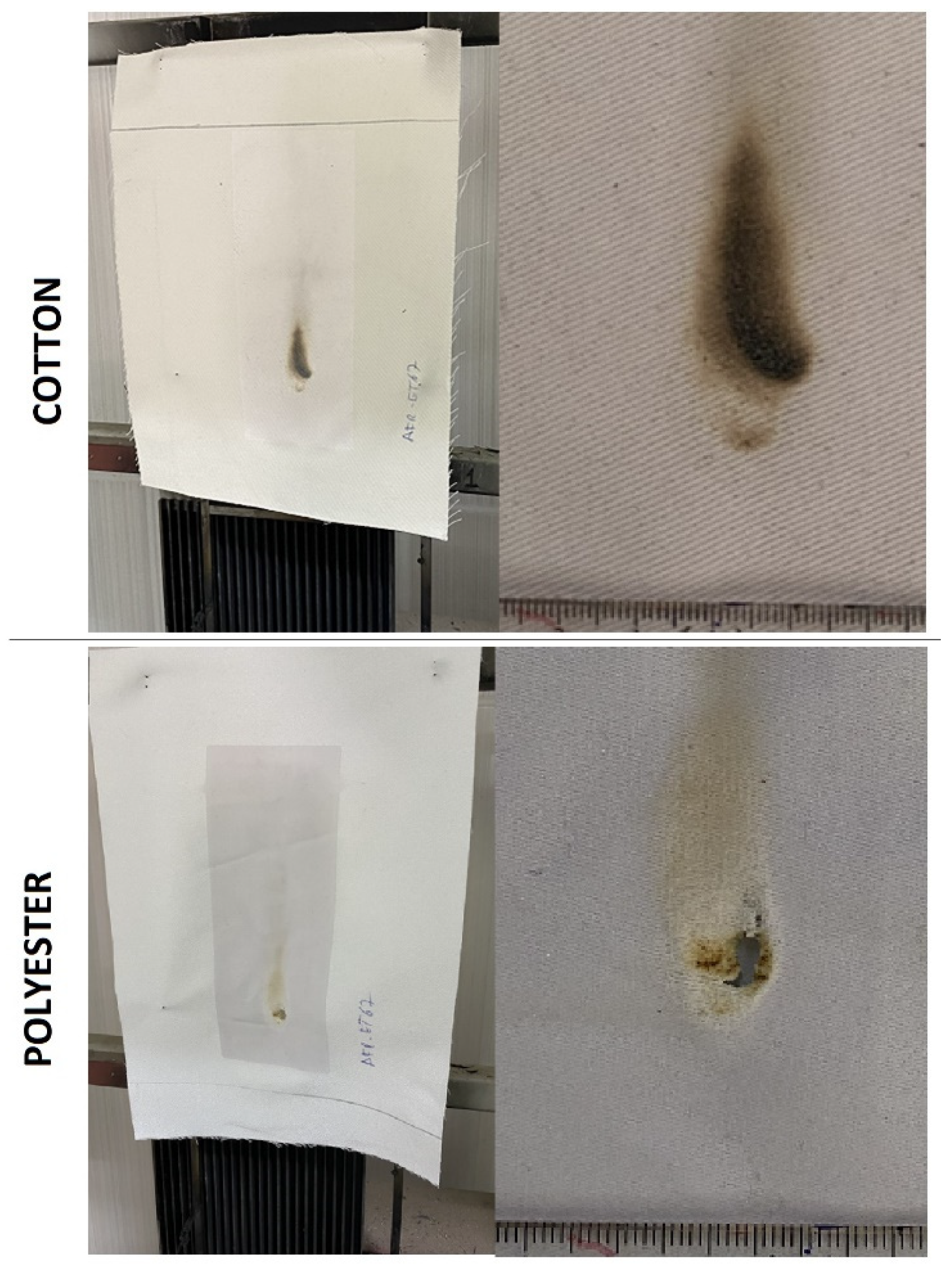
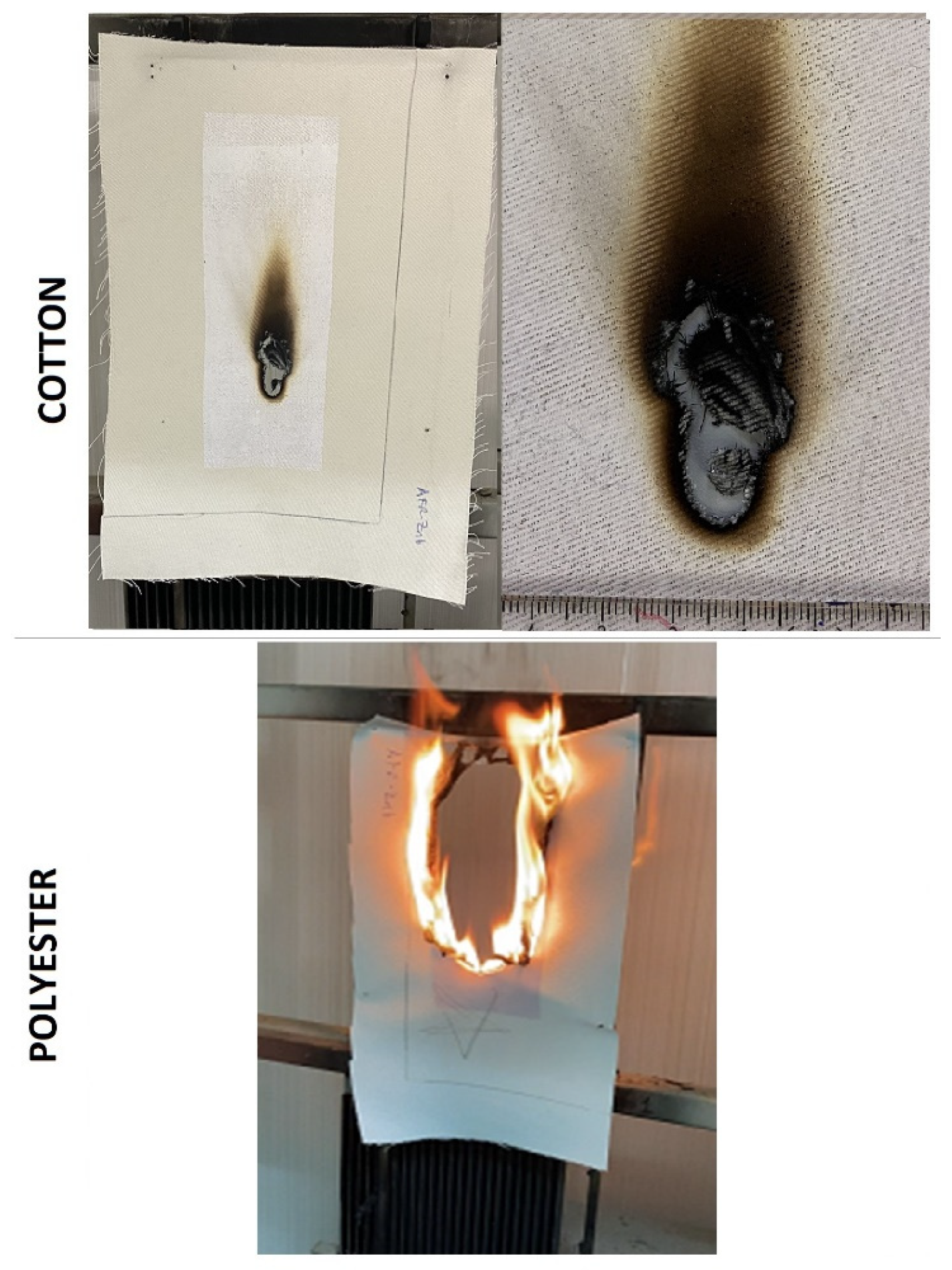
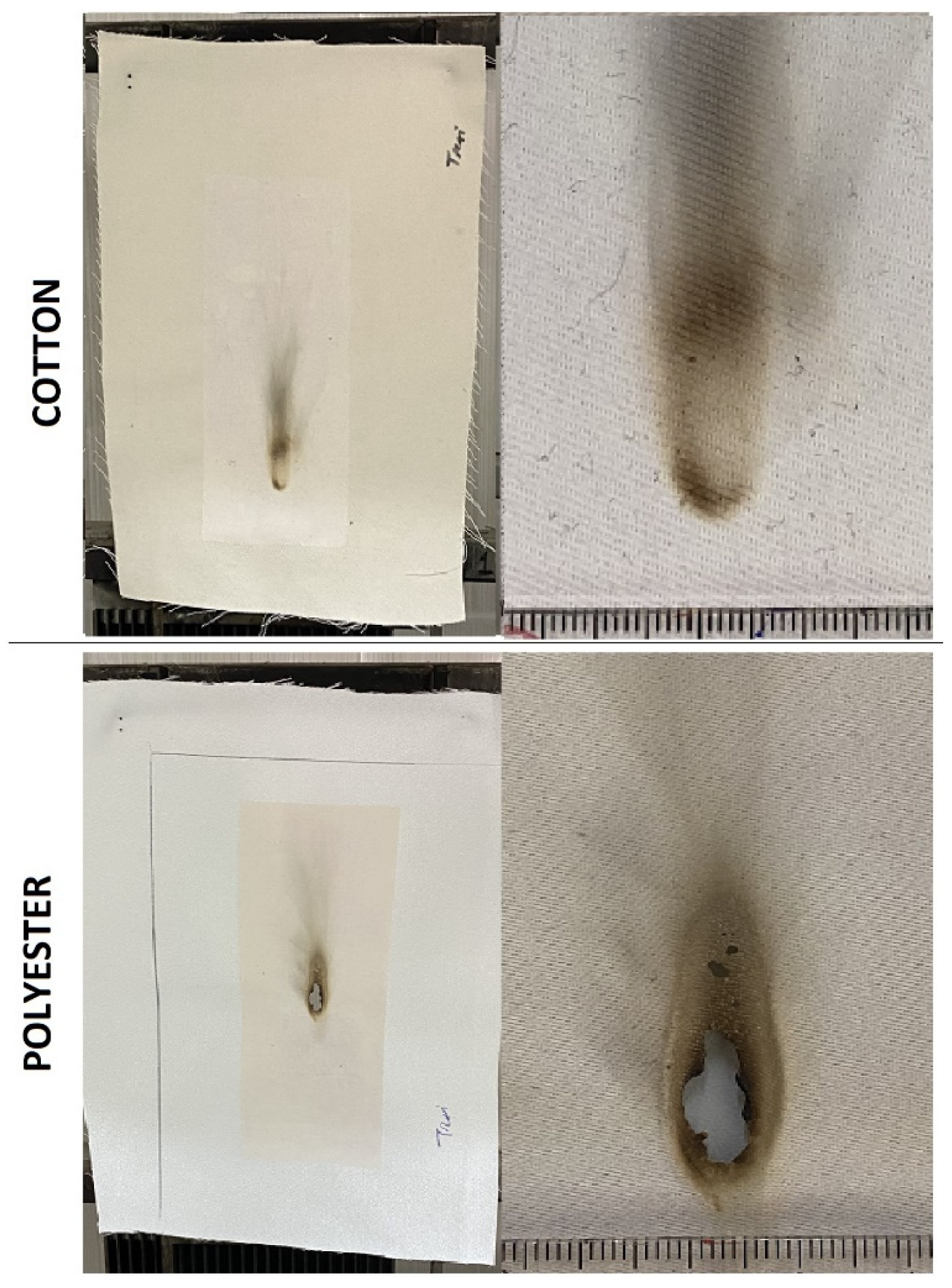
| Coating Composition | Fabric Type | LOI Value (vol. %) |
|---|---|---|
| FR-A | CO | 39.2 |
| FR-A | PE | 26.4 |
| FR-B | CO | 22.6 |
| FR-B | PE | 19.7 |
| FR-C | CO | 28.0 |
| FR-C | PE | 28.8 |
| None | CO | 18.3 |
| None | PE | 19.5 |
Disclaimer/Publisher’s Note: The statements, opinions and data contained in all publications are solely those of the individual author(s) and contributor(s) and not of MDPI and/or the editor(s). MDPI and/or the editor(s) disclaim responsibility for any injury to people or property resulting from any ideas, methods, instructions or products referred to in the content. |
© 2023 by the authors. Licensee MDPI, Basel, Switzerland. This article is an open access article distributed under the terms and conditions of the Creative Commons Attribution (CC BY) license (https://creativecommons.org/licenses/by/4.0/).
Share and Cite
Yilmaz, O.; Kucuk, M.; Darie-Nita, R.N.; Cheaburu-Yilmaz, C.N. Halogen-Free Waterborne Polymeric Hybrid Coatings for Improved Fire Retardancy of Textiles. Polymers 2023, 15, 4496. https://doi.org/10.3390/polym15234496
Yilmaz O, Kucuk M, Darie-Nita RN, Cheaburu-Yilmaz CN. Halogen-Free Waterborne Polymeric Hybrid Coatings for Improved Fire Retardancy of Textiles. Polymers. 2023; 15(23):4496. https://doi.org/10.3390/polym15234496
Chicago/Turabian StyleYilmaz, Onur, Mehmet Kucuk, Raluca Nicoleta Darie-Nita, and Catalina Natalia Cheaburu-Yilmaz. 2023. "Halogen-Free Waterborne Polymeric Hybrid Coatings for Improved Fire Retardancy of Textiles" Polymers 15, no. 23: 4496. https://doi.org/10.3390/polym15234496
APA StyleYilmaz, O., Kucuk, M., Darie-Nita, R. N., & Cheaburu-Yilmaz, C. N. (2023). Halogen-Free Waterborne Polymeric Hybrid Coatings for Improved Fire Retardancy of Textiles. Polymers, 15(23), 4496. https://doi.org/10.3390/polym15234496








